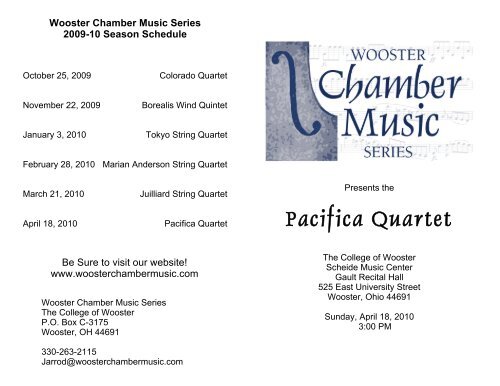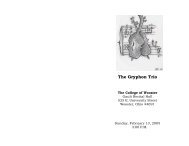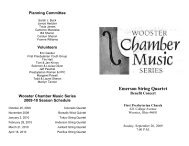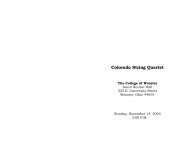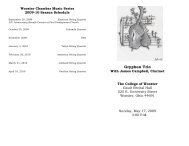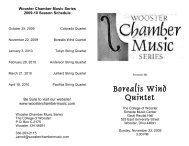Pacifica String Quartet - Wooster Chamber Music Series
Pacifica String Quartet - Wooster Chamber Music Series
Pacifica String Quartet - Wooster Chamber Music Series
You also want an ePaper? Increase the reach of your titles
YUMPU automatically turns print PDFs into web optimized ePapers that Google loves.
<strong>Wooster</strong> <strong>Chamber</strong> <strong>Music</strong> <strong>Series</strong><br />
2009-10 Season Schedule<br />
October 25, 2009<br />
Colorado <strong>Quartet</strong><br />
November 22, 2009<br />
Borealis Wind Quintet<br />
January 3, 2010<br />
Tokyo <strong>String</strong> <strong>Quartet</strong><br />
February 28, 2010 Marian Anderson <strong>String</strong> <strong>Quartet</strong><br />
March 21, 2010<br />
April 18, 2010<br />
Juilliard <strong>String</strong> <strong>Quartet</strong><br />
<strong>Pacifica</strong> <strong>Quartet</strong><br />
Presents the<br />
<strong>Pacifica</strong> <strong>Quartet</strong><br />
Be Sure to visit our website!<br />
www.woosterchambermusic.com<br />
<strong>Wooster</strong> <strong>Chamber</strong> <strong>Music</strong> <strong>Series</strong><br />
The College of <strong>Wooster</strong><br />
P.O. Box C-3175<br />
<strong>Wooster</strong>, OH 44691<br />
The College of <strong>Wooster</strong><br />
Scheide <strong>Music</strong> Center<br />
Gault Recital Hall<br />
525 East University Street<br />
<strong>Wooster</strong>, Ohio 44691<br />
Sunday, April 18, 2010<br />
3:00 PM<br />
330-263-2115<br />
Jarrod@woosterchambermusic.com
A Message to Our Friends<br />
Welcome to our 25 th year! We are so pleased to have reached this<br />
milestone. The <strong>Wooster</strong> <strong>Chamber</strong> <strong>Music</strong> <strong>Series</strong> has been an amazing<br />
venture. We are excited by the year-long celebratory programs we have<br />
planned for you. We began the celebration with the extraordinary<br />
performance by the Emerson <strong>String</strong> <strong>Quartet</strong> in September at our first<br />
Benefit Concert. We are grateful to all of you for having made all of this<br />
possible and are happy to have you here celebrating with us.<br />
We are very appreciative of our faithful audience members, patrons,<br />
benefactors and underwriters whose generosity makes this series<br />
possible. Our thanks to our collective donors whose continuing support<br />
allows us to bring you some of the world’s greatest musicians and<br />
greatest music, and to maintain the <strong>Series</strong> at the least possible cost to<br />
you in terms of ticket prices. Now, more than ever, we need you to keep<br />
on providing that financial backing so that we can keep providing quality<br />
music programming for our community. It is our mission to continue<br />
presenting world-class musicians in this series.<br />
Don’t forget that you are invited after each concert to meet and mingle<br />
with the musicians at a reception in the lobby. We know that you will be<br />
pleased with this year’s roster and that you will enjoy the music.<br />
Yvonne Williams<br />
Director<br />
Advisory Committee<br />
Sarah J. Buck<br />
Jarrod Hartzler<br />
Tricia James<br />
Jay Klemme<br />
Cameron Maneese<br />
Cyril Ofori<br />
Bill & Carolyn Sheron<br />
Yvonne Williams<br />
Thank You<br />
UNDERWRITER<br />
Wayne Boettner & Hildegard K. Wiss-Boettner<br />
Sarah Jane Buck and Nick Amster Fishelson<br />
David and Carol Briggs<br />
Julia Fishelson<br />
Stanley & Flo Gault<br />
Jay Klemme and Anne Wilson<br />
The Donald and Alice Noble Foundation<br />
Cyril and Amelia Ofori<br />
Ken and Jill Shafer<br />
Yvonne C. Williams<br />
Bill & Marilyn Blanchard<br />
Dorothy Carlisle<br />
H. Alberta Colclaser<br />
Marian Taylor Cropp<br />
Com-Patt-ibles Floral Elegance<br />
Mary Grace Engisch<br />
Brian & Karen Gardener<br />
Catherine and Tom Graves<br />
Elinor Hancock<br />
Peter and Tricia James<br />
BENEFACTOR<br />
Ed and Mary Eberhart<br />
Louise E. Hamel<br />
Cally King<br />
Terry Wagner Ling<br />
Lois G. McCall<br />
Clara Louise Patton<br />
Bill and Carolyn Sheron<br />
Frances G. Shoolroy<br />
PATRON<br />
SUBSCRIBER<br />
Ken & Nancy Anderson<br />
Polly & Denny Davis<br />
Richard & Susan Figge<br />
Alice and Larry Gabriel<br />
Liz & Steve Glick<br />
Lucille L. Hastings<br />
Stan & Diane Hales,<br />
*In memory of Annetta Gomez Jefferson<br />
Frank & Barbara Hayes<br />
Frank and Jean Knorr<br />
Beth & Arn Lewis<br />
Lyn Loveless<br />
Sara L. Patton<br />
Kenneth and Louise Plusquellec<br />
Margaret and David Powell<br />
Jon & Pamela Rose<br />
Ed Schrader and Dan Rider<br />
Steve and Cheryl Shapiro<br />
Mary Alice Streeter<br />
Marilyn Tanner<br />
Ken & Carol Vagnini<br />
Kathy and Harry Zink<br />
Marna & William Mateer<br />
Julie Mennes<br />
Steve & Sandy Nichols<br />
Craig & Denise Parker<br />
Elena Sokol and Yuri Popov<br />
Mike & Maxine Smith<br />
Don and Linda Sommer<br />
Peggy and Charles Ulrich<br />
Mina and Don Van Cleef<br />
Meredith Williams<br />
Carol Rueger and David Wiesenberg
<strong>Quartet</strong> in A minor, Op. 132<br />
Ludwig van Beethoven<br />
While working on his Op. 132 quartet during the winter of 1824-1825,<br />
Beethoven fell gravely ill with liver disease, bowel inflammation, and other<br />
painful and debilitating abdominal maladies. The condition left him<br />
seriously weakened, but he was still able to finish the work by July 1825.<br />
Although it has the highest opus number of the three quartets that he<br />
composed at the behest of Russian nobleman and amateur cellist, Prince<br />
Galitzin, it was actually second in order of composition. Study of his<br />
sketchbooks shows that he originally planned the quartet in the traditional<br />
four movements, but on recovering from his sickness decided to replace<br />
the two middle sections with three movements, including the central<br />
Heiliger Dankgesang.<br />
The quartet starts with a short, slow introductory motif that bears a<br />
similarity to the ones heard at the opening of the quartet Op. 131 and the<br />
Grosse Fuge, Op. 133. Emerging from the introductory measures is a<br />
brilliant violin flourish that leads to the main theme, played high in its<br />
register by the cello. Following some expansion, a new idea, starting with<br />
the three repeated notes, is heard and quickly passes through the<br />
quartet, leading to still another distinctive idea – a flowing melody in the<br />
second violin over a nervous, agitated triplet accompaniment.<br />
Wistful and nostalgic in tone, the second movement has two motifs that<br />
run throughout the entire opening section. The first is a pair of rising<br />
three-note figures; the other, and more important, is a long note that<br />
drops down with a little flurry of faster notes.<br />
Over the third movement Beethoven inscribed the words, Heiliger<br />
Dankgesang eines Genesenen an die Gottheit, in der lydischen Tonart<br />
(“Holy Song of Thanksgiving to the Divinity by a Convalescent, in the<br />
Lydian mode”). The sublime hymn expresses his gratitude for the return<br />
of good health; use of the Lydian mode, an ancient ecclesiastical scale<br />
(corresponding to the modern F scale, but without a B flat) gives the<br />
music a spritual tone. The vital and vigorous contrasting second section,<br />
Neue Kraft fühlend (“Feeling of new strength”), evokes a sense of<br />
strength through alternating loud and soft measures that surge with a<br />
powerful, propulsive force.<br />
<strong>Pacifica</strong> <strong>Quartet</strong><br />
Simin Ganatra, violin<br />
Sibbi Bernhardsson, violin<br />
Masumi Per Rostad, viola<br />
Brandon Vamos, cello<br />
PROGRAM<br />
<strong>Quartet</strong> in D Major, Op. 64, No. 5, “The Lark”<br />
Allegro moderato<br />
Adagio cantabile<br />
Menuetto: Allegretto<br />
Finale: Vivace<br />
<strong>Quartet</strong> No. 2 in F, Op. 92<br />
Allegro sostenuto<br />
Adagio<br />
Allegro<br />
INTERMISSION<br />
Franz Joseph Haydn<br />
(1732-1809)<br />
Sergei Prokofiev<br />
(1891-1953)<br />
<strong>Quartet</strong> in A minor, Op. 132<br />
Ludwig van Beethoven<br />
(1770-1827)<br />
Assai sostenuto; Allegro<br />
Allegro ma non tanto<br />
Heiliger Dankgesang eines Genesenen an die Gottheit,<br />
In der lydischen Tonart: Molto adagio; Neue Kraft fühlend:<br />
Andante<br />
Alla marcia, assai vivace<br />
Allegro appassionato<br />
The raucous Alla marcia provides the sudden change in mood, from<br />
heavenly to earthly, which Beethoven seems to need, following moments<br />
of deeply emotional expression. The finale follows the recitative without<br />
pause. Structurally, it combines rondo and sonata form.<br />
--Adapted from Guide to <strong>Chamber</strong> <strong>Music</strong> by Melvin Berger
Biography<br />
Founded in 1994, the <strong>Pacifica</strong> <strong>Quartet</strong> took very little time establishing<br />
prominence on the chamber music scene. They won three top<br />
competitions, early in their career: the Coleman <strong>Chamber</strong> <strong>Music</strong><br />
Competition, the Concert Artists Guild Competition, and the Naumburg<br />
<strong>Chamber</strong> <strong>Music</strong> Competition. Before the end of their first decade, the<br />
group received the prestigious Cleveland <strong>Quartet</strong> Award. More recently,<br />
the <strong>Pacifica</strong> garnered the 2009 Grammy Award for Best <strong>Chamber</strong> <strong>Music</strong><br />
Performance, for their recording of Elliott Carter’s <strong>String</strong> <strong>Quartet</strong>s No. 1<br />
and 5. Also in 2009, <strong>Music</strong>al America recognized them as “Ensemble of<br />
the Year.” They have been praised by critics across the globe, noting,<br />
among other assets, their “stupendous, breathtaking virtuosity” (The<br />
Sunday Times - London); and “astounding performances” (New York<br />
Times). The <strong>Pacifica</strong> <strong>Quartet</strong> has recently been appointed quartet-inresidence<br />
at the Metropolitan Museum of Art in New York, a highly<br />
distinguished position previously held by the renowned Guarneri <strong>Quartet</strong>,<br />
who retired after 43 years.<br />
The <strong>Pacifica</strong> <strong>Quartet</strong> has toured extensively throughout the United<br />
States, Europe, and Asia. Venues they have played include Lincoln<br />
Center, Carnegie Hall, the Library of Congress, the National Gallery, the<br />
Supreme Court in Washington DC, and London's Wigmore Hall. The<br />
current concert season has them performing in three separate European<br />
tours, and participating in Beethoven cycles around the United States,<br />
among many other projects. Future seasons will include performances of<br />
the complete Shostakovich cycle, in addition to more Beethoven cycles.<br />
The <strong>Pacifica</strong> has commissioned and performed as many as eight new<br />
works per year, doing much to further the cause of contemporary music.<br />
The enthusiasm they bring to modern composers (e.g., Elliott Carter,<br />
George Crumb, Osvaldo Golijov, Ligeti) is at least equalled by their<br />
affection for the more familiar composers such as Haydn, Beethoven,<br />
Mendelssohn, and Dvorak. Their recent Grammy-winning CD is the first<br />
of what is now a two-disc set of Carter’s complete string quartets. Other<br />
recordings by the <strong>Pacifica</strong> include the complete quartets of<br />
Mendelssohn, and works by Dvořák, Blackwood, Janáček, Ruth Carter<br />
Seeger, and Hindemith.<br />
Committed to education, the <strong>Pacifica</strong> <strong>Quartet</strong> regularly teaches and<br />
performs at numerous summer festivals. They have fulfilled many visiting<br />
residencies at universities and schools worldwide. Based in Chicago,<br />
they are the Faculty <strong>Quartet</strong>-in-Residence at the University of Illinois at<br />
Urbana-Champaign. They also act as resident performing artists at the<br />
University of Chicago and at the Longy School of <strong>Music</strong> in Cambridge,<br />
Massachusetts.<br />
With three of the members having been friends and collaborators since<br />
their teens, the <strong>Pacifica</strong> <strong>Quartet</strong> first played together on the West Coast<br />
and took their name (and inspiration) from the Pacific Ocean.<br />
-- Sarah J. Buck<br />
Program Notes<br />
<strong>Quartet</strong> in D Major, Op. 64, No. 5, “The Lark” Franz Joseph Haydn<br />
Written in the spring and summer of 1790, Haydn's Opus 64 quartets<br />
were among the last pieces he wrote while still in the employ of the<br />
Esterházy family. Following the death of Prince Nicholas Esterházy in<br />
September, Haydn was discharged from his duties as Kapellmeister after<br />
nearly thirty years of service, albeit with a handsome pension requiring<br />
only that he supply music for a few ceremonial occasions. Free to pursue<br />
a musical career on his own, Haydn travelled to London for a concert<br />
tour, and the six quartets of Op. 64 were published there.<br />
Opus 64, No. 5 bears the nickname “The Lark”—not suggested by the<br />
composer—from the general impression of birdsong in the opening violin<br />
melody. The quartet opens with a repeated simple figure in the lower<br />
instruments over which the first violin glides up in the "Lark" melody. The<br />
mood darkens somewhat as the conversation between voices becomes<br />
more intense and dissonant, but order is finally restored by the opening<br />
theme to end the piece.<br />
<strong>Quartet</strong> No. 2 in F, Op. 92<br />
Sergei Prokofiev<br />
In June 1941, Hitler tore up Germany’s non-aggression pact with the<br />
Soviet Union and hurled his army into a blitzkrieg attack on Russia. A<br />
succession of stunning military victories carried the Nazis deep into<br />
Russian territory. In August, the Soviet government, fearing the<br />
advancing Germans, evacuated a group of leading artists, composers,<br />
and writers, including Sergei Prokofiev, from Moscow to the quiet little<br />
town of Nalchik in the Kabardino-Balkaria Autonomous Republic region of<br />
the northern Caucasus Mountains.<br />
At Nalchik, Prokofiev was introduced to the wealth of folk music from the<br />
area. Prokofiev was inspired to use several of the melodies for a new<br />
string quartet, in which he aimed to achieve “a combination of virtually<br />
untouched folk material and the most classical of classical forms, the<br />
string quartet.” He began work on his <strong>String</strong> <strong>Quartet</strong> No. 2 on November<br />
2 and was finished some five weeks later.


